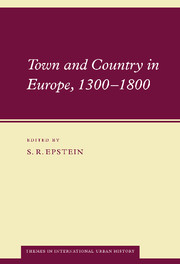Book contents
- Frontmatter
- Contents
- List of figures
- List of tables
- Notes on the contributors
- 1 Introduction. Town and country in Europe, 1300–1800
- 2 Town and country in Sweden, 1450–1650
- 3 Town and country in Holland, 1300–1550
- 4 Town and country in the Dutch Republic, 1550–1800
- 5 Town and country in England, 1300–1570
- 6 Town and country in England, 1570–1750
- 7 Town and country in the Polish Commonwealth, 1350–1650
- 8 Town and country in the Austrian and Czech lands, 1450–1800
- 9 Town and country in Germany, 1350–1600
- 10 Town and country in Switzerland, 1450–1750
- 11 Town and country in France, 1550–1750
- 12 Town and country in Castile, 1400–1650
- 13 Town and country in central and northern Italy, 1400–1800
- 14 Town and country in the kingdom of Naples, 1500–1800
- Index
1 - Introduction. Town and country in Europe, 1300–1800
Published online by Cambridge University Press: 09 November 2009
- Frontmatter
- Contents
- List of figures
- List of tables
- Notes on the contributors
- 1 Introduction. Town and country in Europe, 1300–1800
- 2 Town and country in Sweden, 1450–1650
- 3 Town and country in Holland, 1300–1550
- 4 Town and country in the Dutch Republic, 1550–1800
- 5 Town and country in England, 1300–1570
- 6 Town and country in England, 1570–1750
- 7 Town and country in the Polish Commonwealth, 1350–1650
- 8 Town and country in the Austrian and Czech lands, 1450–1800
- 9 Town and country in Germany, 1350–1600
- 10 Town and country in Switzerland, 1450–1750
- 11 Town and country in France, 1550–1750
- 12 Town and country in Castile, 1400–1650
- 13 Town and country in central and northern Italy, 1400–1800
- 14 Town and country in the kingdom of Naples, 1500–1800
- Index
Summary
‘Town and country’ is among the most abiding metaphors of economic and social development in the past. Relations between town and country are central to several of the most significant ‘grand narratives’ in economic history, including the extension of markets, the rise of capitalism, and the growth of modern manufacture. The metaphor's success is partly dependent on its deceptively simple dichotomy, which is apparent in the very etymology of the term ‘country’: originating in the late Latin contrata, meaning ‘that which lies opposite’, the term subsequently took on in opposition to ‘town’ the meaning of ‘those parts of a region distant from cities or courts’. From its very origin, country came to signify what ‘townness’ was not – a residual meaning, so to speak, which raises the fundamental problem of defining what a town is.
The considerable geographical and historical variation between towns in terms of size, function (industrial, commercial, administrative and cultural), and political and institutional features, makes clear and unambiguous definitions hard to come by. Most historians have chosen either a demographic or a functional definition depending on the questions they wished to answer. The approach pioneered by E. A. Wrigley, Jan de Vries and Paul Bairoch defines urbanity in strictly demographic terms as centres with more than 5,000 or 10,000 inhabitants.
- Type
- Chapter
- Information
- Town and Country in Europe, 1300–1800 , pp. 1 - 29Publisher: Cambridge University PressPrint publication year: 2001
- 5
- Cited by



